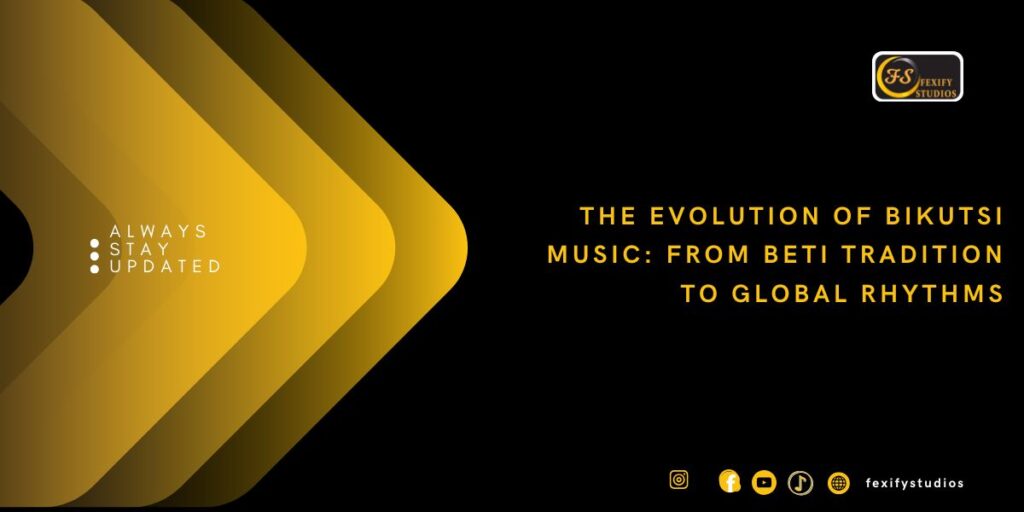The evolution of Bikutsi music is one of Cameroon’s most compelling cultural stories. Rooted in the traditions of the Beti people, Bikutsi has transformed from a communal dance rhythm into a dynamic genre that continues to shape Cameroonian identity and influence global music. Today, Bikutsi is not only a symbol of heritage it’s a living, breathing art form embraced by new generations and fused with modern sounds.

Origins: A Rhythm Born from the Earth
The word “Bikutsi” comes from the Ewondo language, meaning “to beat the earth.” Traditionally performed by women in the Beti ethnic group, Bikutsi was a form of expression used to share frustrations, wisdom, and social commentary through dance and song. Women gathered in circles, stamping the ground rhythmically while singing in call-and-response style. These gatherings were deeply communal, spiritual, and often cathartic.
The genre’s earliest instruments included the mvet (a double-sided harp) and balafon (a wooden xylophone), which provided the melodic and percussive backbone of the music. Bikutsi was performed during ceremonies, funerals, and festivals, often transitioning from mythological storytelling (Ekang phase) to real-life discussions (Bikutsi phase).
Electrification and Modernization
Bikutsi entered the modern era in the 1940s with artists like Anne-Marie Nzié, who brought the genre to radio audiences. But it was Messi Me Nkonda Martin, frontman of Los Camaroes, who revolutionized Bikutsi in the 1970s by electrifying the sound. He mimicked the balafon’s tone using cotton-threaded guitar strings, blending tradition with innovation.
The genre gained international acclaim in the late 1980s with the emergence of Les Têtes Brûlées, a band known for their eccentric style and foam-damped guitar strings that replicated traditional percussion. Their 1988 tour in France and the documentary Man No Run introduced Bikutsi to global audiences.
Style and Themes
Bikutsi is known for its intense 6/8 rhythm, high-pitched vocals, and provocative dance style. Lyrics often explore themes of love, sexuality, politics, and social critique. The genre has always been bold sometimes controversial and deeply expressive.
Modern Bikutsi artists continue this tradition, using the genre to challenge norms and amplify marginalized voices. Female performers like K-Tino, Lady Ponce, and Mani Bella have redefined Bikutsi as a tool for empowerment, especially in a male-dominated industry.
The Current State of Bikutsi Music
Today, Bikutsi remains one of Cameroon’s most popular genres, rivaling Makossa in national prominence. Artists like Lady Ponce, Reniss, Coco Argentée, and Zélé le Bombardier are keeping the genre alive while experimenting with Afro-pop, dancehall, and electronic influences.
Bikutsi is also gaining traction on digital platforms. Songs like “Mon Médecin” and “Je veux souler” by Lady Ponce are trending on YouTube and TikTok, introducing the genre to younger audiences. Producers are incorporating AI plugins and DAWs like FL Studio to modernize the sound while preserving its polyrhythmic essence.
However, some critics argue that Bikutsi is losing its roots amid commercialization. The genre’s traditional instruments and communal spirit are sometimes overshadowed by flashy visuals and pop aesthetics. Yet, many artists are working to balance innovation with authenticity.
Cameroon’s Cultural Export
Bikutsi is more than music it’s a cultural export. It has influenced Western artists like Paul Simon, who incorporated Bikutsi rhythms into his 1990 album The Rhythm of the Saints. Cameroonian artists are now collaborating with international musicians, bringing Bikutsi to new audiences in Europe, Asia, and the Americas.
The genre is also being taught in music schools, featured in documentaries, and celebrated at festivals like FESTIBIKUTSI in Yaoundé. These efforts ensure that Bikutsi remains a vibrant part of Cameroon’s cultural identity.
Final Thoughts: A Rhythm That Endures
The evolution of Bikutsi music reflects Cameroon’s journey resilient, expressive, and ever-adapting. From village circles to global stages, Bikutsi continues to beat the earth with pride and purpose. As new artists rise and technology evolves, the genre will keep dancing forward rooted in tradition, yet open to the world.
Continue to remain informed with our News
Get to know more about your favorite Cameroon artist through their Bio
Fexifystudios also offers so many entertainment Services that you should check out
Check us out on our different communities on Facebook, Instagram, TikTok, and YouTube.
Contact Us and you will be amazed by how much entertainment packages we have installed for you.
Contact Fexify For premium digital services.
Become a digital marketing expert with Fexify Academ
